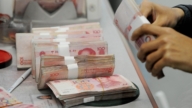【新唐人2013年08月23日讯】中国大陆山东省财政厅最近宣称,将于23号招标发行总额112亿元人民币地方债券。目前,大陆仅4地公布的自行发债规模就将近500亿元,发债形式和发债规模均有所突破。不过,随着政府性巨额债务的明朗化,谁来承担债务风险成了民众关心的问题。请看报导。
这次山东地方债分为5年期和7年期两个固定息品种,计划发行金额均为56亿元﹔8月23号招标,26号开始发行并计息。
另外根据相关公告,新试点自行发债的江苏省今年发债规模也达到153亿元。广东省今年地方政府债券发行额度为121亿元(不含深圳),相对于去年的86亿元同比大幅上升40.7%。此外,上海市今年的发行规模为112亿元。
《每日经济新闻》记者表示,仅查询到上述4个地区公布的自行发债的规模就已经达到了498亿元,远高于去年298亿元。
不过,近年来中共地方政府性债务的快速增长引发了社会各界的广泛关注。
中共国家审计署此前对36个地方政府,自2011年以来的政府性债务审计结果显示,截至2012年底,36个地方政府的政府性债务余额为38475.81亿元。今年5月,中共审计署副审计长董大胜估计,地方政府总债务规模在15到18万亿元;而中共前财政部部长项怀诚提出,地方负债估计超过20万亿元;国外有专家给出了超过40万亿的惊人数字。如果按照巴克莱资本的测算,最多可能达到50万亿元。
据《理财周报》记者统计,大陆“百强县”中至今已有71个县市通过融资平台发行债券,共发行138只债券,融资总计1483.8亿元,再加上信托融资总债务1708.85亿元。
北京天则经济研究所副所长冯兴元:“总体上全国各地一样,尤其是借新还旧比较严重。像2010年江苏省的负债总额,已经占了地方政府财政收入的12倍,很高的。”
据公开资料显示,现在很多地方政府债务已进入集中兑付期,而一些地方政府的融资平台的债务。远远超过了它们的财政土地收入的担保能力,如果继续举债,风险将变得越来越大。
但是,地方政府的投资计划却非常惊人。
去年7月,湖南省长沙市对外宣布,将投资8292亿元用来搞建设和产业专案;同年8月,贵州省推出3万亿的刺激计划。但是,贵州省2011年财政总收入才是1330亿元,而长沙市2011年的地方财政收入也只有668.11亿元。
经济专栏作家段绍译指出,这是地方政府花钱不受老百姓监督和没有相关法律约束的结果。
经济学者北京师范大学MBA导师段绍译:“每一个政府官员他都希望花更多的钱,主要是这个原因,并且每一届政府欠了债不需要自己还,可以把债务留给下一届政府。”
北京天则经济研究所副所长冯兴元表示,地方政府周期性的更替,使他们有机会对一些投资企业、施工队的债务赖账不还。但目前地方政府还可以靠银行的理财信托资金来融资,其他管道就都很困难了。
不过,段兴元透露,基于目前的经济状况,中共当局准备启动新一轮的4万亿投资计划来刺激经济发展。
著名经济学家郎咸平近日撰文指出,2008年“四万亿投资”计划的后果是让鄂尔多斯等“鬼城”拔地而起,地方政府负债大增。到去年年底,4万亿到期的债务只还了1万亿,各商业银行不得不同意地方政府对剩下的3万亿推迟还款。
段绍译:“在中国,只要共产党领导,地方政府破产是很难的,因为国家可以发行钞票,稀释老百姓手中的货币值,割本利来还贷。”
段绍译进一步指出,蒸发老百姓手中货币的本质就是抢钱,这是强盗行为。这不仅会造成老百姓对政府的不信任,也会产生经济泡沫。
采访/陈汉 编辑宋风 后制/钟元
Who Is At Risk? Four Local Chinese Governments Release 50 Billion Bonds
The Department of Finance in Shandong Province stated
11.2 billion Yuan of local bonds will be issued on August 23.
Currently, the published total of self-issued bonds
from only four provinces have reached 50 billion Yuan.
The form and scale of these bonds is record breaking.
However, along with huge government debts, the public
are concerned about who will bear the risk for the bonds.
Local bonds in Shandong Province are divided
into 5-year and 7-year fixed-rate varieties,
with a planed amount of 5.6 billion Yuan.
August 23 will see tenders released, and on the
26, it will start issuing interest bearing bonds.
In addition, according to the information, a
new pilot this year for self-issued bonds in
Jiangsu Province has issued 15.3 billion Yuan.
The amount of Guangdong Province local government
bonds this year is 12.1 billion Yuan (excluding Shenzhen).
This increased significantly by
40.7% compared with last year.
The amount for Shanghai is 11.2 billion Yuan.
reports that, only these four
provinces have self-issued bonds of 49.8 billion Yuan.
This is much higher than 29.8 billion Yuan last year.
However, the recent rapid growth in the Chinese Communist
Party (CCP) local government bonds’ has gathered attention.
The CCP National Audit Office (NAO)’s audit gives
details of 36 local governments’ debt since 2011.
It indicates that up until the end of 2012, the debt for these
36 local governments amounted to 3.85 trillion Yuan.
In May this year, the CCP NAO Vice General Auditor
Dong Dasheng estimated that, local governments’
total debt will be around 15 to 18 trillion Yuan.
The former CCP Finance Minister Xiang Huaicheng said
local debt is estimated to be more than 20 trillion Yuan.
Foreign experts have given a number of over 40 trillion Yuan.
If according to Barclays Capital estimates,
it may have reached up to 50 trillion Yuan.
reports that among China’s “Hundred
Counties", 71 issue bonds through a financing platform.
In total, there were 138 bonds financing 148.38 billion Yuan.
In addition, there was a total of 170.88 billion trust financing.
Feng Xiangyuan, Deputy Director of Beijing Tianze Institute
of Economics: “In general throughout the country,
borrowing for repaying is very severe.
For example, in 2010, Jiangsu Province’s total debt was
12 times the local government revenue, which is very high."
According to public information, many local
governments have entered a debt payment period.
Some local governments’ debts from the
financing platform is much higher than the
guarantee level of their finance land revenue.
If they continue to borrow, the risk
will become greater and greater.
However, local governments’ investment
plans are very unbelievable.
Last July, Changsha in Hunan announced that 829.2 billion
Yuan will be invested in construction and industrial projects.
Last August, Guizhou Province launched a 3 trillion
Yuan stimulus plan, but in 2011, their yearly fiscal
revenue was only 133 billion Yuan.
Changsha City’s local annual fiscal
revenue is only 66.8 billion Yuan.
Duan Shaoyi, an economics expert, said that this is the
result of local governments’ spending money without
public supervision, and lacking relevant legal binding.
Duan Shaoyi: “Every government
official wishes to spend more money.
Besides, the debt from one government
can be passed to the next government."
Feng Xiangyuan points out that the periodical change of
local governments offers the opportunities to delay debts
of some investment enterprises or construction teams.
Now the local governments can still rely on
the bank’s financial trust funds for finance,
while other channels are very difficult to reach.
However, Duan Xingyuan thinks that, based on the current
economic situation, the CCP authority plans to use 4 trillion
Yuan of investments to stimulate economic development.
Well-known economist Lang Xianping
recently commented in an article.
In 2008, the “Four Trillion Investments"
created many “Ghost Towns", such as Ordos.
It created a dramatic increase in local governments’ debts.
At the end of last year, only 1 trillion
was repaid out the 4 trillion Yuan.
The commercial banks had to agree on the local
governments’ delay in repaying the other 3 trillion Yuan.
Duan Shaoyi: “In China, as long as the CCP governs,
local governments cannot become easily bankrupt.
This because the state can issue bank notes, dilute the
Value of currency, and cut interest to repay the debts."
Duan Shaoyi further explains that to evaporate people’s
money is basically stealing money, which is banditry.
This makes the people distrust the government,
and will generate an economic bubble.






























